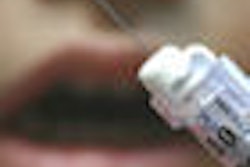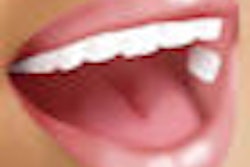Can you say, "the sixth sheik's sixth's sheep's sick?" Maybe so, but many of your patients can't when they leave your office. Now you can legally inject them with a drug to make such tongue twisters (and normal eating and speaking) possible much quicker, according to Novalar Pharmaceuticals of San Diego.
The FDA has approved the use of phentolamine mesylate as the first-ever drug for reversing local anesthesia, the company announced today. Novalar, which holds a patent on this use of phentolamine, plans to begin marketing the drug at the annual ADA meeting in October under the name OraVerse.
"I'm really pleased that we could offer dentists a product they never had before," said Novalar president and CEO Donna Janson.
Also today, the company released some of the data used to win the FDA's approval.
"We were clearly able to show that phentolamine accelerates the recovery of normal sensation," said researcher Elliot V. Hersh, D.M.D., M.S., Ph.D., a professor of dental pharmacology at the University of Pennsylvania.
When injected with the drug, patients' lips felt normal after about half an hour instead of an hour and a half without the drug, the researchers reported. For adults, that difference amounts to more comfort and better quality of life. Patients can return to work without fear of drooling at an important meeting, Dr. Hersch said, speaking at the American Association for Dental Research (AADR) meeting April 5.
"We said, 'Give me a big smile.' We gave them tongue twisters," he said. "We gave them water to see if it dribbled out."
But the drug may find its most important application in children, according to Dr. Hersh. "The pediatric dentists are going to love this," he said. That's because many children chew their numb cheeks or lips, sometimes causing severe damage.
Two randomized, double-blind controlled trials on the drug took place at 18 centers across the U.S. and included 484 adult dental patients, according to the company press release.
In these adult studies, phentolamine reduced the median recovery time in the lower lip (as measured by lip tapping) by 85 minutes compared to control, the company said.
Within one hour after administration of OraVerse, 41% of patients reported normal lower lip sensation compared with 7% in the control group, a statistically significant difference, Novalar reported.
A similar multicenter trial enrolled 152 pediatric patients, divided into a control group and a phentolamine group. The median time to normal sensation in patients age 6 to 11 was reduced by 75 minutes for the OraVerse-treated group, a 56% acceleration of the time to normal sensation, the company reported.
No one in these studies reported an adverse reaction more serious than transient pain in the injection site, according to the Novalar statement. The company anticipates publishing these data in forthcoming issues of the Journal of the American Dental Association and Compendium of Continuing Education in Dentistry.
The drug has been tested and found effective in six of the eight drug formulations commonly used in dentistry, said Paul A. Moore, D.M.D., Ph.D., M.P.H., a professor of dental pharmacology at the University of Pittsburgh who conducted some of the research and served on Novalar's advisory board.
He said it seems to work in:
- 4% articaine HCl with 1:200,000 epinephrine
- 4% articaine HCl with 1:100,000 epinephrine
- 0.5% bupivacaine with 1:200,000 epinephrine
- 2% lidocaine HCl with 1:100,000 epinephrine
- 3% mepivacaine with 1:20,000 neocobefrin
- 4% prilocaine HCl with 1:200,000 epinephrine
He said it has not been tested in:
- 4% prilocaine HCl without vasoconstrictor
- 3% mepivacaine without vasoconstrictor
Dr. Moore said the drug could be used with any minor procedure, such as a restoration, in which long-term anesthesia isn't needed.
Phentolamine, an alpha-adrenergic blocking agent, does not reverse anesthetics themselves. Instead, it competes with epinephrine (or neocobefrin) for receptors. Epinephrine and neocobefrin are included in most dental anesthetic formulations as vasoconstrictors to keep the anesthetic in the targeting area. If blood vessels dilate, blood can wash the anesthesia away. By blocking the vasoconstrictors, phentolamine accelerates this clearance.
Phentolamine has been used since the 1950s as an antihypertensive in a 5- to 10-mg dose, and can cause fainting and other side effects in these doses. A 1.7-mL cartridge of OraVerse contains only 0.4 mg of phentolamine. Dentists can inject OraVerse as a cartridge in the same manner and in the same site as anesthetics.
Copyright © 2008 DrBicuspid.com



















